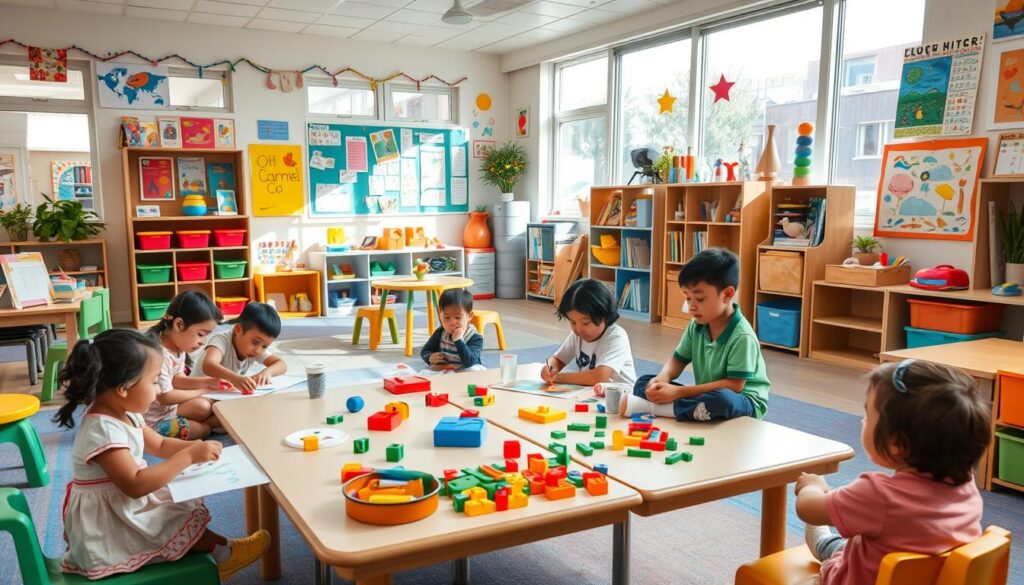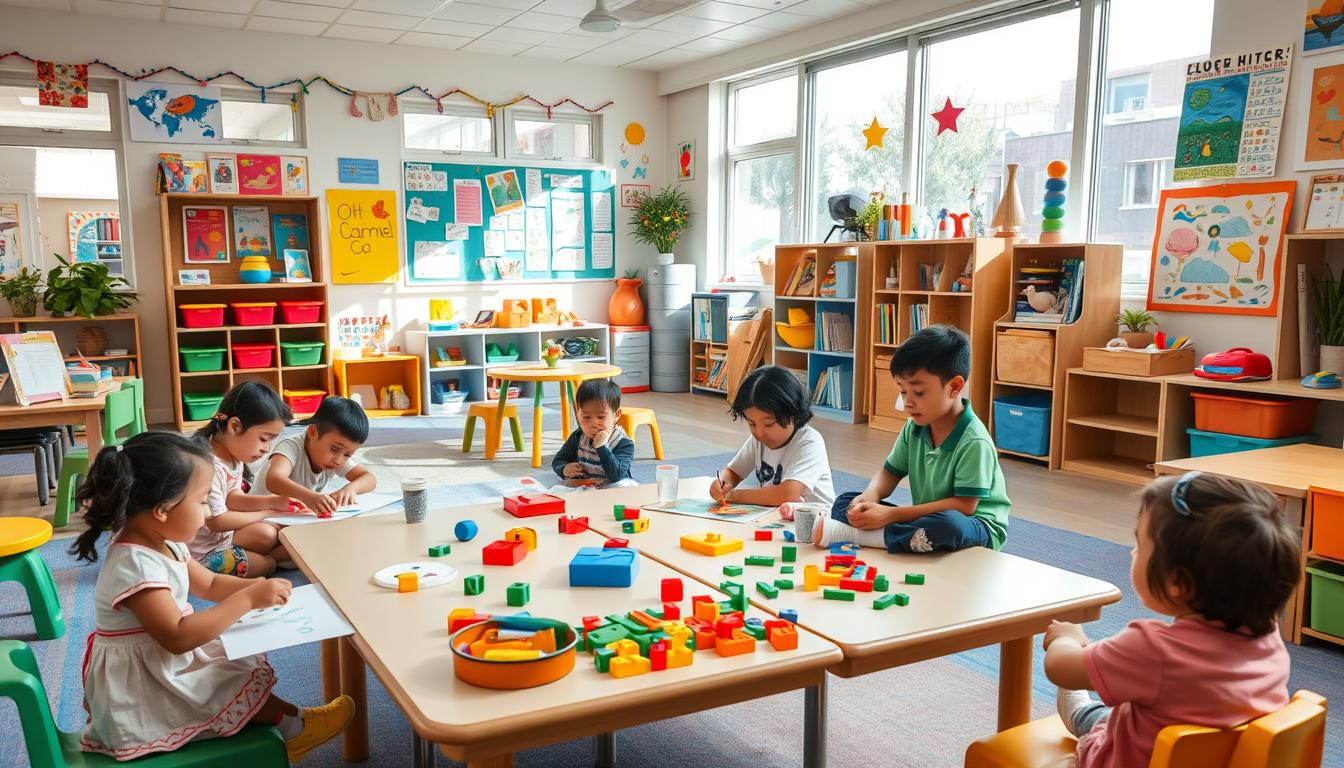Investing in early childhood education is key for a child’s growth. These programs are for kids from birth to age 5. They offer a place where kids can learn, explore, and get important life skills.
These programs use different ways to help kids grow. They include play-based learning and structured curricula. This variety supports the full development of young minds.

At the core of these programs is understanding young learners’ needs and potential. Early childhood educators create fun, age-right activities. They also build positive relationships with kids.
This helps kids become curious, creative, and love learning. As they grow, they learn not just academics but also important skills. These skills help them in school and life.
Key Takeaways
- Early childhood education programs focus on the holistic development of children from birth to age 5.
- These programs use diverse teaching methods, including play-based learning, to support cognitive, social, and emotional growth.
- Investing in early childhood education lays a strong foundation for children’s future academic and personal success.
- Early childhood educators create nurturing environments that foster curiosity, creativity, and a love of learning.
- Comprehensive early education programs address not only academic skills but also critical thinking, problem-solving, and social-emotional development.
Understanding the Foundations of Early Childhood Education Programs
Effective early childhood education programs start with strong developmental principles and educational philosophies. These basics shape how young children learn and grow. They guide the design and implementation of early learning initiatives.
The Building Blocks of Early Learning
At the heart of early childhood education is a deep understanding of child development. Educators need to know the key milestones and learning theories for children’s growth from birth to age eight. This knowledge helps create engaging, age-appropriate curricula that nurture each child’s unique potential.
Historical Development of Early Education
The roots of early childhood education go back centuries. Pioneers like Friedrich Fröbel and Maria Montessori set the stage for today’s approaches. The field has evolved, influenced by philosophies like constructivism, play-based learning, and whole-child development. Knowing this history is key to building on past successes and lessons.
Core Educational Philosophies
Early childhood education programs follow various educational philosophies. Each has its own view on how young children learn best. From Reggio Emilia’s child-centered approach to Montessori’s structured, sensory-rich environment, these principles are the foundation for engaging, developmentally appropriate learning experiences.
| Educational Philosophy | Key Principles |
|---|---|
| Montessori | Emphasis on hands-on, self-directed learning; multi-age classrooms; specialized teaching materials |
| Reggio Emilia | Collaborative, project-based learning; importance of the physical environment; teacher as co-learner |
| Constructivism | Learning as an active, meaning-making process; emphasis on problem-solving and critical thinking |
By grasping the foundations of early childhood education, educators and policymakers can craft programs that support young children’s holistic development. This sets them up for long-term academic and personal success.
Benefits of Quality Early Childhood Education Programs
Quality early childhood education programs have a big impact on a child’s growth. They get ready for kindergarten and learn important social skills. These skills help them succeed in life.
Early education boosts a child’s thinking skills. Kids in good preschools and daycare do better in solving problems, speaking, and remembering things. They do better than kids without these programs.
Early education also helps with social and emotional skills. Kids learn to work with others, control their feelings, and feel for others. These skills are key for doing well in school and life.
Most importantly, these programs make kids ready for school. They grow in a safe place that helps their body, mind, and feelings. This means they do well in kindergarten and later in school.
| Benefit | Description |
|---|---|
| Cognitive Development | Improved problem-solving skills, enhanced language proficiency, and stronger memory recall |
| Social-Emotional Skills | Cultivation of interpersonal skills, emotion regulation, and empathy development |
| School Readiness | Significant enhancement of a child’s overall preparedness for the academic and social demands of kindergarten |
By choosing quality early education, parents and leaders open doors for the future. They help kids start strong in school and life.
“High-quality early childhood education lays the groundwork for children to thrive academically, socially, and emotionally throughout their educational journey.”
Types of Early Learning Environments and Teaching Methods
Early education is key for young children’s growth. It includes play-based learning and established teaching methods. These help shape a child’s early years.
Play-Based Learning Approaches
Play-based learning focuses on a child’s curiosity and enthusiasm. It uses hands-on activities and imagination. This way, teachers help kids develop important skills through play.
Montessori Method
The Montessori method was created by Dr. Maria Montessori. It focuses on self-directed learning in a prepared environment. Teachers guide kids through activities that help them learn at their own pace.
Reggio Emilia Approach
The Reggio Emilia approach comes from Italy. It sees children as capable learners. Kids explore their interests and express themselves through art and music.
These teaching methods show the variety in early education. They meet the needs of different learners. By using these methods, teachers create engaging environments for kids to learn and grow.
Essential Components of Preschool Curriculum Development
Creating a good preschool curriculum is key for a child’s future learning. It should cover important areas like literacy, numeracy, science, arts, and physical education. This helps kids grow in all ways and get ready for kindergarten.
Literacy and Language Development
The literacy part of preschool focuses on basic language skills. Kids learn about sounds, letters, and reading. They enjoy stories and rhymes, which helps them love reading and understand words better.
Numeracy and Mathematical Concepts
Math in preschool introduces kids to numbers and shapes. They learn to count, sort, and solve simple problems. Hands-on games make math fun and help them think critically.
Exploration of the Natural World
Science in preschool lets kids explore the world around them. They do experiments and talk about what they see. This makes them curious and ready to learn more about science.
Creative Expression and the Arts
The arts in preschool help kids be creative. They paint, draw, sing, and play. These activities improve their skills, problem-solving, and how they feel about themselves.
Physical Development and Wellness
Physical education in preschool is all about being active. Kids play games, move around, and go outside. This helps them stay healthy and strong.
By mixing these important parts, preschool curriculum helps kids learn in a complete way. It prepares them for kindergarten readiness and success in life.
| Curriculum Component | Learning Objectives | Key Activities |
|---|---|---|
| Literacy and Language Development | Phonemic awareness Letter recognition Early reading comprehension | Storytelling Rhyming games Exposure to diverse literature |
| Numeracy and Mathematical Concepts | Counting Sorting and patterns Basic operations | Hands-on activities Mathematical games Exploration of relationships |
| Exploration of the Natural World | Scientific inquiry Observational skills Understanding natural phenomena | Experiments Nature observations Discussions and discoveries |
| Creative Expression and the Arts | Fine motor development Artistic expression Imagination and creativity | Painting and drawing Music and movement Imaginative play |
| Physical Development and Wellness | Gross motor skills Coordination and balance Healthy habits | Structured play Movement games Outdoor exploration |
“The preschool years are a critical time for laying the foundations of lifelong learning. By designing a well-rounded curriculum that addresses the diverse needs of young children, we can unlock their full potential and set them up for future academic and personal success.”
Social-Emotional Development in Early Education
Early childhood is key for growing social-emotional skills. These skills are the base for a child’s happiness and success. In early education, we focus on these skills to help kids grow emotionally and socially.
Building Emotional Intelligence
Emotional intelligence means knowing and managing your feelings and others’. Early education helps kids learn to understand and control their emotions. They also learn to see things from others’ points of view.
Developing Social Skills
Good social skills help kids talk, work together, and make friends. Early education programs use group activities and play to teach these skills. Kids learn to share, solve problems, and communicate well.
Creating Positive Relationships
The early years shape a child’s relationships and growth. Early education programs help build strong bonds by teaching kids to be supportive and friendly. They encourage kids to interact with each other and feel part of a community.
TO WATCH VIDEO CLICK HERE
| Emotional Intelligence | Social Skills | Positive Relationships |
|---|---|---|
| Self-awareness, self-regulation, empathy | Communication, cooperation, conflict resolution | Supportive behaviors, peer interactions, sense of community |
By focusing on social-emotional skills in early education, we help kids thrive. This sets them up for a bright future in school and life.
The Role of Technology in Modern Early Education
Technology is now a big part of early childhood education. Young learners today are used to a digital world. Technology in the classroom brings interactive learning experiences.
It’s important to balance screen time with hands-on activities. Technology can help learning, but kids need to stay active and social. Teachers should choose digital tools that are fun and educational for young children.
Fostering Creativity and Collaboration
Technology helps kids be creative and work together. Interactive software and games teach problem-solving and teamwork. Digital tools make learning fun and engaging.
Personalized Learning Opportunities
Technology lets teachers tailor learning to each child. Early childhood teachers use digital tools to find out what each child knows and what they need to learn. This way, they can plan lessons that fit each child’s learning style.
| Technology in Early Childhood Education | Benefits |
|---|---|
| Educational apps and games | Engaging, interactive learning experiences that promote skill development |
| Virtual field trips | Exposure to diverse environments and cultures without leaving the classroom |
| Coding and robotics activities | Cultivating computational thinking and problem-solving skills from an early age |
| Interactive whiteboards and touchscreen devices | Enhancing collaboration, creativity, and hands-on learning opportunities |
As early childhood education programs grow, technology’s role becomes more important. By using digital tools well, early education can create a rich learning environment. This prepares students for the 21st century.
Parent Engagement and Family Partnerships
Early childhood education programs know how important parents and families are. They work together with educators to help children get ready for school. This teamwork is key for a child’s success in school and beyond.
Communication Strategies
Good communication is the heart of parent engagement. Teachers should talk regularly with families, sharing how their child is doing and listening to their thoughts. This way, everyone works together to meet the child’s needs.
Family Involvement Activities
- Invite parents to join in classroom activities, like reading or art.
- Plan family events, like seasonal celebrations or field trips, for bonding and learning.
- Ask parents to help out, whether it’s on field trips or leading clubs.
Supporting Learning at Home
Learning doesn’t stop when school ends. It’s important for families to keep learning at home. Teachers can give families tools, like activity kits or book suggestions, to help with learning.
Strong partnerships with families make early childhood education powerful. They help ensure every child is set up for success in school and in life.
Assessment and Progress Monitoring in Early Education
Assessment and progress monitoring are key in early childhood education programs. They help teachers understand each child’s growth and needs. This information guides them in making the best teaching choices to support child development and prepare for kindergarten readiness.
Early education uses various assessment methods. These include:
- Observation-based assessments to track children’s skills and behaviors
- Authentic performance-based assessments through hands-on activities
- Standardized assessments to measure specific developmental milestones
Teachers use this data to understand each child’s strengths and areas for improvement. This helps them tailor lessons and celebrate children’s successes.
Progress monitoring is an ongoing effort. It lets teachers track children’s growth and adjust their teaching as needed. Tools like regular check-ins and developmental checklists help ensure children meet important child development milestones.
“Effective assessment and progress monitoring are the cornerstones of high-quality early education, empowering educators to meet the unique needs of each child and support their journey towards kindergarten readiness.”
Early childhood education programs that focus on assessment and improvement create a supportive environment. Here, every child can grow and reach their highest potential.
Creating Inclusive Early Childhood Environments
In early childhood education, making spaces inclusive is key. This ensures every child, no matter their needs or background, feels important and ready to succeed.
Supporting Diverse Learners
Inclusive classrooms focus on early intervention. They offer special help and tools for each student. This might mean using new teaching methods or getting help from experts.
Cultural Competency in Education
It’s vital for teachers to understand and respect different cultures. This way, they can make learning fun and meaningful for kids from all walks of life. It helps kids feel they belong and learn about different cultures early on.
Accessibility Considerations
Accessible spaces are important for inclusive classrooms. They need to be easy for all kids to use. This includes using technology to help, making communication options available, and arranging the room for everyone’s comfort.
“Inclusion is not just about disability. It is about all children, all families, and all communities feeling valued, respected, and connected.”
Early childhood educators play a big role in creating supportive spaces. By focusing on diversity, accessibility, and cultural understanding, they help kids grow and thrive. This builds a fair and welcoming world for everyone.
Professional Development for Early Childhood Educators
Ongoing professional development is key for early childhood educators. It helps them keep up with the latest teaching methods. By getting an early childhood education degree or taking online courses, they can learn more about child development and teaching strategies.
Early childhood education degree programs cover important topics like child psychology and classroom management. They give educators the skills to create fun and supportive learning spaces for young kids. Online courses are also available, making it easier for busy educators to learn new things.
When early childhood teachers invest in their own growth, they show they care about doing a great job. This not only helps the children they teach but also improves the whole field of early childhood education.
FAQ
What are the key components of an effective early childhood education program?
Good early childhood education programs focus on play and social skills. They offer hands-on learning and value family involvement. This helps children grow and learn well.
How do early childhood education programs benefit child development?
Quality early education boosts thinking skills, social skills, and readiness for school. It lays a solid base for future learning and success.
What are some common teaching methodologies used in early childhood education?
Early education often uses play, Montessori, and Reggio Emilia methods. These focus on exploration, discovery, and growing the whole child.
How can technology be integrated into early childhood education programs?
Technology can make learning fun and engaging when used wisely. It includes digital tools and interactive activities. A balance between tech and hands-on learning is key.
What is the importance of parent engagement in early childhood education?
Parents play a big role in early education. Good communication and family activities help children feel ready for school. It makes learning a family affair.
How do early childhood education programs support diverse learners and inclusive environments?
Inclusive programs welcome all children, no matter their needs. They focus on cultural understanding and accessibility. This ensures every child feels included and valued.
What professional development opportunities are available for early childhood educators?
Teachers can grow through degrees, online courses, and training. This keeps them up-to-date and helps them improve their teaching.
TO SEE MORE TOPICS CLICK HERE

